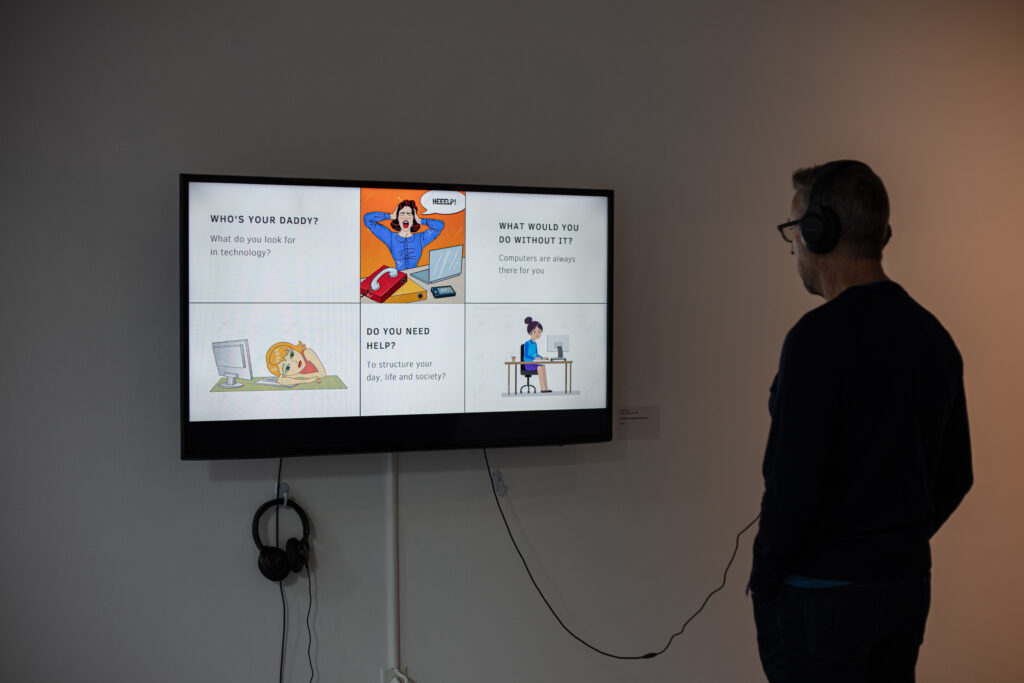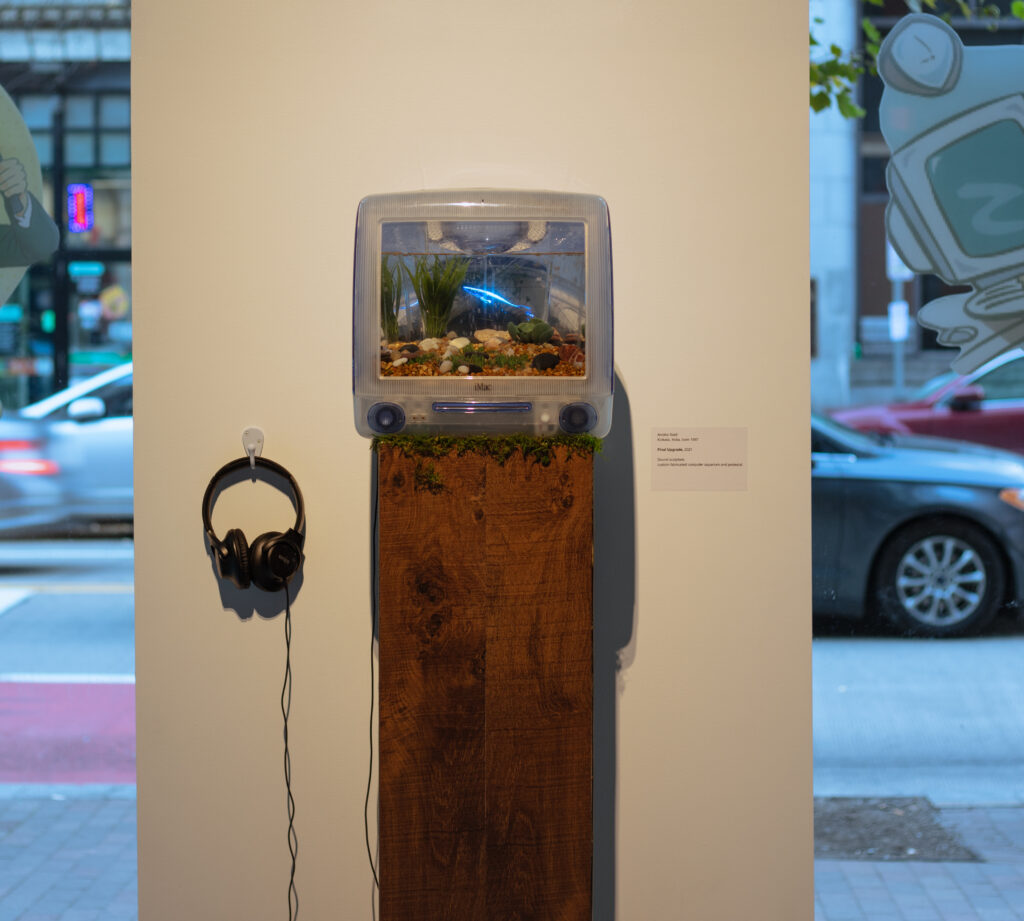Silicon Valley Sally: Anisha Baid’s MS User
Review by Emma Riva

Installation view of MS User at 820 Gallery
The views and opinions expressed in this article are solely those of the author. They do not reflect the opinions or views of Bunker Projects or its members. All images courtesy of Anisha Baid.
Anisha Baid spent so many nights talking to Cortana, Microsoft’s artificial intelligence assistant, so often that her roommate started asking her if she was okay. “I kept thinking to myself—how can I be in solidarity with this weird fictional character? How can I make her real?” she recalled. These subservient female voices like Cortana, Siri, and Alexa are ubiquitous parts of modern life, and it’s easy to brush off the profoundly disturbing idea that when we create software to serve us, its default is a woman. Baid could have conversations with Cortana, but Cortana existed only to serve her, to assist her.
Baid’s solo exhibition at 820 Gallery, MS User, is an outgrowth of these questions about gender, technology, and labor. The male employees of Xerox Park in Silicon Valley created the earliest computers with Sally, their secretary, in mind. Very little information exists about Sally. “The origin of what I’m doing and what everyone is doing as users is based in this specific woman’s behavior. I wanted to imagine about what she actually did in her day to day life,” Baid said. MS User exposes the psychological fabric of our technological lives: The office. Every mass-use computer takes its inspiration from the shuffling of papers and memos in a corporate office, the movement of a secretary, rendering each of us as secretaries of our own lives. Even when we are not working in an office, the computer is an office space for us, with a trash can, a notepad, a calendar rendered in skeuomorphism, a term for when an object in cyberspace looks like its real-life counterpart—i.e., the trash icon that looks like a garbage can. Alongside curator Tara Fay Coleman, Baid made and assembled a series of works investigating the skeuomorphism we take for granted.

Anisha Baid, Breaking the (Glass) Screen (2023)
One of the focal points of MS User is the stock image, depicted on the gallery walls and then as part of a PowerPoint-esque piece entitled Breaking the (Glass) Screen (2023). Baid first encountered stock images while working for her father as a graphic designer, where she would be asked to find stock images of smiling white people. “It made no sense for a company in India,” she said. “One time, I found this image of an angry woman in front of a computer, and it tied into this broader idea I wanted to explore about feminine rage and the computer.” The stock images splashed across the window of 820 gallery are pixelated around their edges. Stock images are a particular kind of kitsch. The shadow of text across it reminds the viewer that the image is not purely theirs. If you really investigate the idea of a stock image, it’s a surreal and disturbing one—you have to pay to use a cartoon image of a woman looking happy and productive? The pixelation or the logo of VectorStock is a marker that the very image you’re looking at does not belong to you.

Anisha Baid, installation view of MS User (2023)
Baid left the stock images she used in their lower-resolution form. “For a second I thought, should I buy the hi-res image? Then I was like, no, fuck you, I’m going to use it with the watermark,” she said. “To me, stock images are everything that’s wrong with representational culture.” I asked her what she meant by representational culture—broadly, it’s the idea that there is some dominant system that teaches us how to see ourselves through images. MS User’s subversive quality lies in how it exposes that design, that there was a time in human history when offices and secretaries did not exist. That as disturbing as some systemic problems can be, they are cages of our own creation. Maybe that just makes them more disturbing.

Anisha Baid, Final Upgrade (2021)
A standout piece in MS User is Final Upgrade (2021), positioned at the front of the 820 space. Baid had to waterproof an old iMac computer to make a gutted out “Macquarium” with a holographic fish inside of it, accompanied by an audio piece that uses a combination of her own voice and a robotic one. The upward movement of bubbles inside of the water-filled iMac meditative and difficult to look away from. The audio monologue starts with “Before I was an image, I was a fish…” and you only know it’s ended once it loops and begins again with the same line. Glass of wine in one hand, phone in the other, I was transfixed by the piece at the opening. Baid creates installation experiences that manage to make technology, something usually stale and ubiquitous, feel otherworldly, mystical, fantastical.
Baid’s mixture of sound, text, and image is in line with Sarah Sze’s Timelapse at the Guggenheim, which used installation to take apart images and question how we look at art in the first place. Past the storied movements of impressionism, expressionism, post-impressionism, neo-expressionism, whatever, the way people look at images in modern life is fundamentally different than it was in a pre-computer age. Successful contemporary art, in the techno-corporate information overload world we live in, has to play with perception as Sze and Baid do. Baid’s engagement with images also reminded me of Ester Petukhova’s work in here gallery’s recent If and When You Find Me. Like Baid, Petukhova traced the ways online subcultures reproduce images and leave strange breadcrumb trails of meaning across our consciousnesses. The line between words, images, and sound becomes blurrier and blurrier as our society finds more ways to technologically merge them.

Anisha Baid, Research Studio (2023)
There’s a sort of mid-2000s to early-2010s digital kitsch that feels more human than the sleek, minimalist design of contemporary phones, and Baid leans into that. Think the music video for “Dilemma” by Nelly, wherein Kelly Rowland texts Nelly on an Excel spreadsheet on a Nokia. There’s something kind of touching about the attempts at human connection within the digital world. Kelly Rowland writes WHERE YOU AT? HOLLA AT ME WHEN YOU… in an empty spreadsheet cell and then tosses her Nokia to the ground. In the early 2010s, I tapped out lengthy email threads to my friends on my iPod Touch while poaching WiFi off whatever coffeeshop or library was nearest to me. The skeuomorphism of early Apple and Microsoft icons and the UX (user experience) of this bygone era feels friendlier, somehow. Maybe it’s that the human loneliness within those interactions and interfaces felt more palpable. Everything, from the Giant Eagle logo to the depiction of Ms. Frizzle in a reboot of the Magic Schoolbus cartoons, seems to be paring itself down to a minimalist corporate culture, an aesthetic charge helmed by Silicon Valley. “There’s something cruel about the fact that someone decides how you see the world. You are taught to be a particular kind of user,” Baid reflected.
But one of the strengths of Baid’s exhibition is its sense of humor within the large-scale existential questions. In Self Portrait as Tech Support (2021), Baid took her own image and created a mousepad out of it. The type of mousepad is one meant to abate symptoms of carpal-tunnel syndrome, but it also pokes fun at the “titty mousepad” phenomenon where a user can rest their hand on the silicon facsimile of breasts, often of an anime character. (Sidebar: In college, I had a casual quasi-sexual encounter with someone who had one of these. He was a virgin and had no idea what was going on. Draw your own conclusions). In Research Studio (2023), an interactive space, Baid recreated someone’s actual desktop background she saw at a cyber-café in India. The user had made their desktop look like a real desk with shelves where each application icon would go. Baid referenced this idea of “the desk-ness of life”—that no matter what we do, we are sitting at a desk designed to keep us in line. Computers were designed by men, for men with a woman to push their papers around, and now that digital office space has a huge amount of psychic control over our lives.

Anisha Baid, Self Portrait as Tech Support (2021)
It’s easy to feel a sense of despair at the gaping maw of corporate culture slowly eating human happiness in a grotesque, disturbing world where we can summon fictional female digital servants at will and men can rest their aching hands on the fake boobs of any 2D woman they want. But what takes MS User to a deeper, more intimate, and more hopeful place is how Baid incorporates writing and sound. When you walk into 820, you hear notes of piano. They originate in Sally’s Helper, an audiovisual projection in the back of the space wherein Baid programmed piano keys to correspond to words as she typed out a poem reflecting on Sally’s role in digital history. “That work for me is a kind of fulcrum or endpoint to the exhibition,” Baid said. “It really dawned on me that working at a computer, I forgot about my body. The body-mind divide is so exaggerated that we think of computers as an extension of the mind. But our bodies are also involved.” In Research Studio, she invites gallerygoers to type on a screen of their own, which also corresponds to piano notes. It makes the act of writing, which often feels stale compared to visceral slashes of acrylic of canvas or the frenetic plucking of guitar strings, feel more physical.
I asked Baid which words made the best sound to her. She demonstrated: The phrase Quiet-words makes a soft, twinkling series of notes. People-power. Inside-outside. Secretary. Computer. And finally, the gentle melody of the name Sally. To watch her type out the original Microsoft user’s name, slowly, deliberately, and to hear the sound is an earnest, touching thing. Despite that I type these words in the digital world made in Sally’s image, she could never speak for herself. Baid offers her a voice, one not made for following orders in the name of maximum productivity, but the soft, soft, subtle, wordless note of peace.
MS User is on view through February 18th, 2024 at the 820 Gallery in downtown Pittsburgh.
Emma Riva is an art writer, author, and curator based in Pittsburgh, PA. She spent her childhood in the Washington Heights neighborhood of New York but now calls the Rust Belt region home.
Emma serves the managing editor of UP, an international online and print magazine covering street art, graffiti, fine arts, and their intersections in popular culture, and is the founder of Petrichor, a web magazine about the arts in Pittsburgh. She is also a staff writer at Belt and a contributor to Bunker Review, Widewalls, Pittsburgh Jewish Chronicle, Newcity, Whitehot Magazine, Table Magazine, and Rust Belt Girl.



